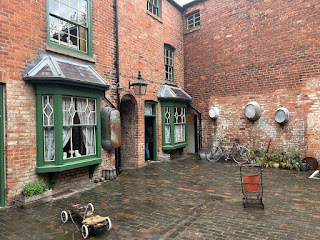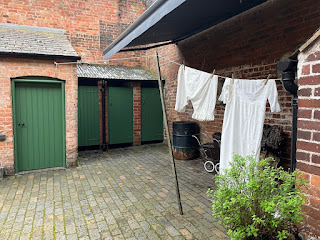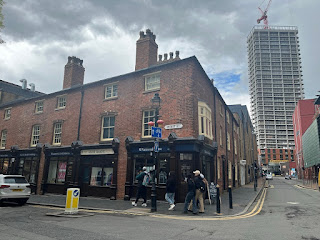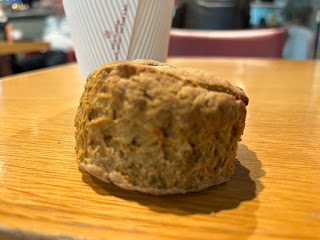For the past 10 years, I've had two lists of National Trust properties. The first of those lists is called "National Trust Places That Serve Scones".
The second list is called "National Trust Places That Sound Brilliant But Don't Serve Scones And I Have To Visit The Scone Ones First."
Birmingham Back to Backs, a set of working class houses in the centre of Birmingham, was always very high up on List #2. So when I recently completed all 244 properties on List #1 (read about my final trip to the Giant's Causeway here), I booked my tour slot and set off for the West Midlands.
But before I tell you about the very fascinating Birmingham Back to Backs, I have to correct a previous oversight of mine.
One of the publications that recently covered the completion of this National Trust Scone Quest was the New York Times. The writer quoted a few lines from this blog, in which I had talked about different types of National Trust visitor. I had mentioned the "Expert Visitor", the one who thinks they know more than the guide and keeps correcting them on details, usually getting on everyone's nerves.
But I had failed to include the very best type of National Trust visitor: the "Lived-It Visitor". These are the people who have first hand experience of what you're looking at, which means they ask brilliant questions or make really insightful comments. They're very rare - you don't often find yourself in a tour group with the current Earl of Lichfield - but when you do bump into one, your entire experience is so greatly improved by their insights that you feel like you should be paying them for sharing their knowledge. My best example is when I went to Souter Lighthouse and met a woman whose husband had grown up in the lighthouse keeper's cottage.
Anyway: today I was lucky enough to encounter some Lived-It visitors. They hadn't grown up in these specific back to back houses, but they remembered some of what we were seeing, which made it all the more interesting.
(I have to add, though, that our tour guide had clearly met a few Expert Visitors in her time. She was by far the most knowledgeable and accomplished tour guide I've met at the NT, yet the fear was never far from her eyes that someone was going to question the width of the candles or something similar. It must be quite trying.)
But let me tell you a bit about the Back to Backs:
What are back to backs?
- Back to back courts were a type of urban housing built mainly in the Midlands and the North during the 19th century
- A back to back court features a group of houses built around a central courtyard that contains the shared toilet and laundry facilities
- Back to backs were different to terraced houses. Terraced housing was often made up of homes containing two rooms upstairs and two downstairs. In contrast, a back to back house was usually only one room deep. If you imagine a terraced house split down the middle by a wall, you'd get a back to back - one house looked out onto the street, while the house behind it looked into the courtyard.
- Tenements were different again - they were more like houses split into multiple horizontal dwellings, flat-style, with a shared stairs.
How old are the Birmingham Back to Backs?
Who lived in the Birmingham Back to Backs?
- 1840s: The Levy family was living in Court 15 in 1851, having moved from London. The family was Jewish, and there was a synogogue and a Hebrew School nearby. Lawrence Levy was a watchmaker.
 |
| The Levys' kitchen |
- 1870s: The Oldfield family moved in during the 1860s and comprised of Herbert and Ann with their 10 children. Herbert was a glassworker, making glass eyes as well as eyes for dolls and stuffed toys.
- 1930s: The Mitchell family lived in Court 15 for 95 years, which is unusual as most families moved around a lot. The Mitchells were locksmiths.
- 1970s: George Saunders ran his tailoring business from the houses fronting onto Hurst Street. George had come to Birmingham from St Kitts in the Caribbean. He moved out in 2002 and was instrumental in helping to protect the buildings.
Why did these Back to Backs survive?
Even by the 1870s, there was pressure to get rid of the back to backs. They were seen as unsanitary. But removing them was not an easy task - in 1875, almost half the population of Birmingham was living in a back to back. New houses were built, however, and back to backs were emptied and demolished. Court 15 was condemned for domestic habitation in 1966 but it was never knocked down, probably due to the shops that existed on Hurst Street. The Birmingham Conservation Trust took on the properties in the 1990s, with the National Trust taking over once renovations were complete.
You need to see the Back to Backs for yourself to appreciate how miraculous it is that they've survived. I grew up in a small town with streets of Victorian terraced houses and today I was fully expecting to find myself walking down row upon row of red brick buildings. But it's not like that at all - you're in a world of casinos and modern developments and then suddenly this little pocket of working class housing appears in front of you.
The Birmingham Back to Backs are without doubt one of the very best National Trust properties that I've been to. The property is really well set out and organised so you get a real sense for how the back to backs evolved over the 130 years when people lived in them. My tour guide was excellent - she talked for over an hour an a half, but the time flew by. I highly recommend a visit.
Birmingham Back to Backs: 5 out of 5
Scone: There's no cafe at Birmingham Back to Backs. I did take a Ginger & Treacle scone with me that I'd made myself using the recipe from the National Trust Book of Scones. It's always a winner, as it's a fiery little bake.





Maybe for your National Trust properties that do not serve scones you could find a nearby cafe that does serve scones.
ReplyDeleteA fun way to carry on your scone adventure :-)